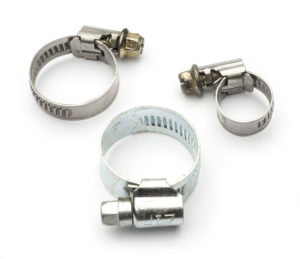 If you don’t know already, hose clamps are multipurpose attachment tools most commonly used to connect one piece of tubing or pipe to another, manufactured to create a tight seal between hose and barb. There are many types of automotive hose clamps, plumbing hose clamps, and other styles, each designed for specific uses.
If you don’t know already, hose clamps are multipurpose attachment tools most commonly used to connect one piece of tubing or pipe to another, manufactured to create a tight seal between hose and barb. There are many types of automotive hose clamps, plumbing hose clamps, and other styles, each designed for specific uses.
However, though they seem simple enough to use, there are some common hose clamp mistakes that fixers and crafters should avoid to get the best use out of these handy little gadgets. Here are just a few:
Mistake # 1: Using the Wrong Size Clamp
Different projects require different hose clamp sizes. Circumference and strength are both important to get the job done. Be sure to measure the outside of the hose, with the barb or fitting already inside. You can use measuring tape or calipers to determine the diameter. Improper measuring can cause to improper seals, leading to a leak or even a burst.
Mistake # 2: Using Metal Hose Clamps with Silicone Tubing
While many projects require tough-surface hosing, like rubber hose, some tubing is made of silicone. Silicone can be appropriate for a variety of projects, such as high-heat applications. However, the surface of silicone is softer than rubber. Traditional metal hose clamps can wear and shred silicone, decreasing its functionality over time. For silicone hosing, be sure to buy silicone-specific hose clamps to ensure a durable and tight seal.
Mistake # 3: Using the Wrong Clamp for the Job
There are three main types of hose clamps: worm gear clamps, wire clamps, and spring clamps. Each type is ideal for different applications. A worm gear clamp looks like a circular metal band, which is threaded through itself to gradually tighten around a piece of hose, rather like a belt. Spring clamps are made of steel and are forced open like mouthless jaws that clamp around a piece of tubing when released. Finally, wire clamps are overlapping pieces of bent wire that clamp more and more tightly around a when a captive nut and screw are tightened.
Different types of automotive hose clamps and hose clamps, in general, have benefits and drawbacks. Fixers should do research before choosing any type of clamp for a specific project. For example, a spring clamp is a good choice in a small space, where tightening motions would be difficult, but spring clamp strengths are limited to however strong the person is– if you can’t force the spring open, you can’t use the clamp! Make sure the hose clamp you choose is the best type for your project.
Whether you’re using hose clamps to fix your leaking pipes, or getting creative with different types of automotive hose clamps, be sure you’re avoiding these mistakes so that your project is a success!

